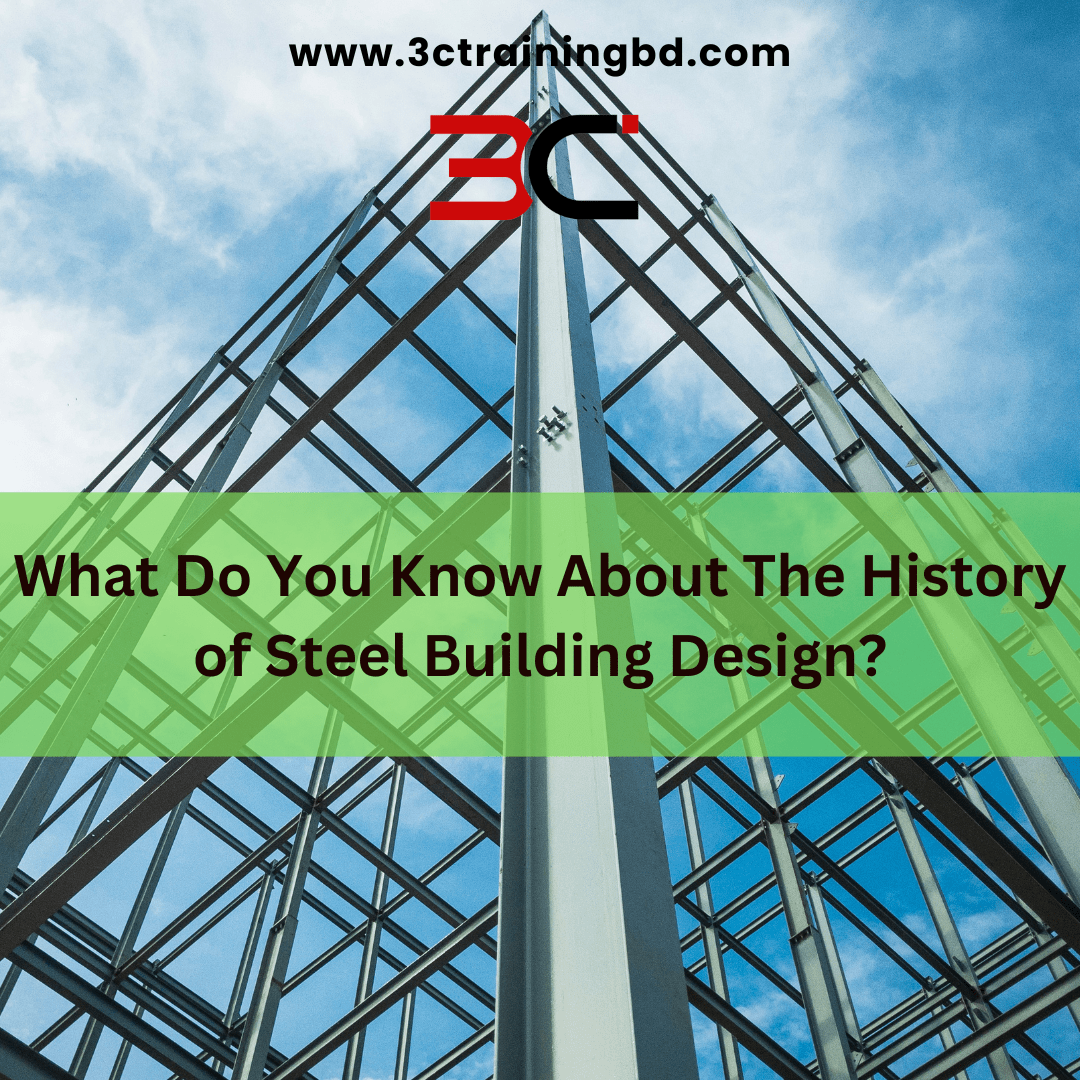Being the most trusted material, steel has been used to construct buildings and infrastructure. Because steel construction is sturdy, long-lasting, and affordable to build, the construction sector uses the most steel.
Steel offers great adaptability and flexibility. That is why constructors, designers, and architects can employ steel in a variety of ways to build their dream structures. As a result, steel has been used as a crucial material for building structures. Therefore, there is a rich history of steel building design.
We will go through the history and current use of steel in construction today. We will also discuss various types of steel building construction and the process. So, stay tuned.
Designing Steel Buildings: A Brief History
Despite being used in construction for a very long time, iron or steel is more recent than you think. The construction of steel buildings started during the Industrial Revolution, which was distinguished by the widespread manufacture of contemporary steel.
In the early days of steel construction, train stations were one of the primary applications. Churches, homes, and other buildings were added once steel construction was proven to be profitable. The first steel-framed structures, including skyscrapers, appeared in the late 1800s.
Early in the 20th century, steel construction gained popularity, and it expanded widely during WWII. At that time, it was used for building oil storage and military shelters. Steel became more widely accessible after the war and eventually became a common material. Steel was used as a primary building material to produce some of the most recognizable structures, including the Empire State Building.
By the turn of the 20th century, modern steel manufacturing had made it possible to build railroads all over the world, opening up new territories in far-flung areas.
The Timeline of Steel Construction Highlights
- Brooklyn Bridge completed in 1883
- The home insurance building was completed in 1885 (often seen as the first skyscraper)
- Eiffel Tower completed in 1889
- Woolworth building completed in 1912
- The Chrysler building was completed in 1930
- Empire State building completed in 1931
- Steel, LLC founded in 1947
- Seagram building completed in 1958
- U.S. Steel tower completed in 1971
- Willis Tower (Sears Tower) completed in 1973
- Burj Khalifa completed in 2009
Types of Steel Building Construction
Talking about high-rise steel building construction, there are several types. More advanced types are being introduced day by day. In general, there are mainly 4 types of steel structure buildings.
They are –
- Portal Frame Steel Building Structures
Reference: (havitsteelstructure.com)
The most popular type of light steel structure is the portal frame. The major force-bearing components of the portal steel frame are either welded section steel or hot-rolled steel. The components can also include steel pipe and cold-formed C/Z steel. It also uses a lightweight roof and wall construction.
On the other hand, a rigid portal frame is a structure with firmly linked beams and columns. It shows some remarkable qualities, like lightweight and moderate stress. As a result, it is frequently utilized in commercial, agricultural, institutional, and industrial buildings.
- Steel Building Frame Structures
Reference: (havitsteelstructure.com)
Steel beams and columns make up the steel frame construction. These can handle both vertical and horizontal loads. To provide a flexible arrangement and a greater area, columns, beams, bracing, and other parts are firmly joined. It is extensively utilized in multi-story super high rise steel building construction. This type of structure is used in commercial conference facilities, office buildings, and other structures.
- Steel Truss Structure
Reference: (havitsteelstructure.com)
Several rods with hinges at both ends make up the steel truss framework. It may be separated into space and plane trusses. It can also be separated into tube trusses and angle steel trusses, as described in the components section.
Most of the time, the steel truss structure is composed of the followings –
- The upper chord
- The lower chord
- A vertical rod
- A diagonal web
- An inter-truss support form
In comparison to solid web beams, steel trusses utilize less steel, have less structural weight, and are stiffer.
- Steel Grid Structure
Reference: (havitsteelstructure.com)
The grid structure is made up of numerous rods in accordance with a specified rule. This type of structure has great earthquake resistance, low space stress, and high stiffness. It is used for building gyms, airplane hangars, and exhibition spaces.
The Steel Building Construction Process
Usually, steel fabrication is the first step of the steel building construction process. The process of transforming raw materials into the final item is known as steel fabrication. This item is sent to a job site. Typically, the architect or customer of the project starts steel fabrication by offering blueprints that show the ultimate design of the structure along with the specific parts that need to be produced.
These might be anything from generic components to more specialized ones, including beams of certain sizes or decorative components. To make this a reality, the steel fabricator often works away from the job site.
In the next stage, shop drawings that detail every product component are created using sophisticated software. These are created with the client’s specifications, budget, and reviews in mind. Following everyone’s approval of the shop designs, the fabricator actually fabricates each component.
Finally, each item is brought to the job site to make the actual component. The original drawings must be followed by the steel erectors to guarantee that the steel components of the structure are installed and properly placed. The sections are often placed using accurate measuring instruments and large lifting equipment, such as cranes. On-site fabrication is occasionally possible, although it is typically less effective.
The Design of Steel Building Construction
The design of steel buildings should be prominent. To make is happen, the design process must include several things like –
- The architectural design
- The analysis of the steel structure
- The creation of the structural idea
- The verification of the members
Steel alternatives to concrete ones are lighter, with the potential to offer more column-free flexible floor area, fewer foundations, and a quick, safe construction schedule.
A steel solution for the designer entails guaranteed material, section quality, and exact off-site fabrication. The solution must also specify complete assistance, including software, design manuals, and user-friendly resistance tables.
Basic Cost of Steel Building Construction
The cost of steel buildings depends on multiple factors. Due to their complex self-weight, traditional reinforced concrete structures require significant foundation treatment. In terms of soil quality, the foundation will cost more than half of the entire cost of the building.
With that said, a steel structure building is relatively light. As a result, less reaction force will be faced at the bottom of the column. This is how this structure can reduce the expense of foundation treatment.
The Present and Future of Steel Construction
We are also going to predict the present and future of steel construction, just like we have discussed its history or past. So without further ado, let’s talk about the present and future of street construction.
The Present
Over time, things in the steel industry have evolved. One reason is that steel no longer requires intensive labor, which originally led to staff reductions. Due to the fact that the bulk of steel is manufactured in China, Japan, and India, international markets are becoming more competitive.
Steel is 100% recyclable, therefore yesterday’s steel served as the foundation for today’s buildings, and today’s steel structures will very probably be recycled into tomorrow’s structures.
Today, it is employed in every conceivable building application, and the scope is expanding. It may be used in conjunction with other building supplies, including glass, cold-rolled and galvanized flat items that are robust, weldable, and have high elastic limits.
The Future
Steel is ideal for modular construction. Thanks to new technologies that will expand the use of steel in building modeling. Although more recent materials like graphene may sound exciting, they are not expected to replace steel anytime soon.
The requirement for steel in buildings will only increase as long as there is a sustained need for reliable infrastructure. Demand for steel will only increase due to the rising population and increasing cities. We think that steel’s durability, adaptability, and sustainability will lead to more uses in construction, not fewer.
Conclusion
Well, that was pretty much everything about the history of steel building design. There is no doubt that steel has always been a novel material for construction and it will always be considered.
Having said that, there are a number of intriguing new developments in the construction sector that will probably have some effect on the steel market. The steel business will undoubtedly advance more during the modern era of science and technology.
Steel Building Related Courses

